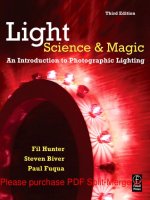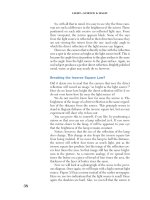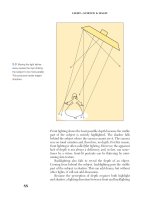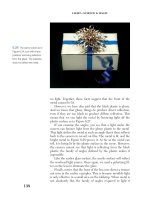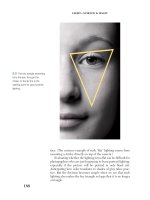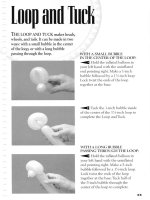Light—Science & Magic- P1
Bạn đang xem bản rút gọn của tài liệu. Xem và tải ngay bản đầy đủ của tài liệu tại đây (3.75 MB, 50 trang )
Please purchase PDF Split-Merge on www.verypdf.com to remove this watermark.
Light—Science & Magic
Hunter-FM.qxd 12:1:07 9-27 PM Page i
Please purchase PDF Split-Merge on www.verypdf.com to remove this watermark.
Hunter-FM.qxd 12:1:07 9-27 PM Page ii
Please purchase PDF Split-Merge on www.verypdf.com to remove this watermark.
Light–
Science & Magic
An Introduction to Photographic Lighting
Third Edition
Fil Hunter
Steve Biver
Paul Fuqua
Amsterdam
•
Boston
•
Hiedelberg
•
London
New York
•
Oxford
•
Paris
•
San Diego
San Francisco
•
Singapore
•
Sydney
•
Tokyo
Focal Press is an imprint of Elsevier
Hunter-FM.qxd 12:1:07 9-27 PM Page iii
Please purchase PDF Split-Merge on www.verypdf.com to remove this watermark.
Acquisitions Editor: Diane Heppner
Publishing Services Manager: George Morrison
Project Manager: Paul Gottehrer
Assistant Editor: Stephanie Barrett
Marketing Manager: Christine Degon Veroulis
Cover Design: Alisa Andreola
Interior Design: Gene Harris
Focal Press is an imprint of Elsevier
30 Corporate Drive, Suite 400, Burlington, MA 01803, USA
Linacre House, Jordan Hill, Oxford OX2 8DP, UK
Copyright © 2007, Elsevier Inc. All rights reserved.
No part of this publication may be reproduced, stored in a retrieval system,
or transmitted in any form or by any means, electronic, mechanical, photo-
copying, recording, or otherwise, without the prior written permission of
the publisher.
Permissions may be sought directly from Elsevier’s Science & Technology
Rights Department in Oxford, UK: phone: (+44) 1865 843830, fax: (+44)
1865 853333,
E-mail: You may also complete your request
on-line via the Elsevier homepage (), by selecting
“Support & Contact” then “Copyright and Permission” and then “Obtaining
Permissions.”
Recognizing the importance of preserving what has been written, Elsevier
prints its books on acid-free paper whenever possible.
Library of Congress Cataloging-in-Publication Data
Application submitted
British Library Cataloguing-in-Publication Data
A catalogue record for this book is available from the British Library.
ISBN-13: 978-0-240-80819-2
ISBN-10: 0-240-80819-3
For information on all Focal Press publications
visit our website at www.books.elsevier.com
07 08 09 10 11 5 4 3 2 1
Printed in the United States of America
Hunter-FM.qxd 12:1:07 9-27 PM Page iv
Please purchase PDF Split-Merge on www.verypdf.com to remove this watermark.
v
Contents
Chapter
1
How to Learn Lighting
3
What Are “The Principles”? 4
Why Are the Principles Important? 4
How Were the Example Subjects Chosen for This Book? 5
Do I Need to Do These Exercises? 6
What Kind of Camera Do I Need? 7
Should I Shoot Film or Digital? 8
What Lighting Equipment Do I Need? 10
What Else Do I Need to Know to Use This Book? 11
What Is the “Magic” Part of This Book? 11
Chapter
2
Light: The Raw Material of Photography
13
What Is Light? 14
How Photographers Describe Light 17
Brightness 17
Color 18
Contrast 19
Light versus Lighting 22
How the Subject Affects the Lighting 24
Transmission 24
Direct and Diffuse Transmission 26
Absorption 27
Reflection 28
Chapter
3
The Management of Reflection and the Family of Angles
31
Types of Reflection 32
Diffuse Reflection 32
The Inverse Square Law 36
Direct Reflection 37
Breaking the Inverse Square Law? 38
The Family of Angles 39
Hunter-FM.qxd 12:1:07 9-27 PM Page v
Please purchase PDF Split-Merge on www.verypdf.com to remove this watermark.
CONTENTS
vi
Polarized Direct Reflection 41
Is It Polarized Reflection or Ordinary Direct Reflection? 45
Turning Ordinary Direct Reflection into
Polarized Reflection 46
Applying the Theory 47
Chapter
4
Surface Appearances
49
The Photographer as Editor 50
Capitalizing on Diffuse Reflection 51
The Angle of Light 52
The Success and Failure of the General Rule 55
The Distance of Light 57
Doing the Impossible 59
Using Diffuse Reflection and Shadow to Reveal Texture 62
Capitalizing on Direct Reflection 65
Competing Surfaces 68
Try a Lens Polarizing Filter 70
Use a Still Larger Light 71
Use More Than One Light 72
Use a Gobo 73
Complex Surfaces 74
Chapter
5
Revealing Shape and Contour
79
Depth Clues 81
Perspective Distortion 81
Distortion as a Clue to Depth 82
Manipulating Distortion 83
Tonal Variation 84
The Size of the Light 85
Large Lights versus Small Lights 86
Distance from the Subject 86
The Direction of the Light 87
Light on Side 89
Light above the Subject 90
Fill Light 91
Adding Depth to the Background 95
How Much Tonal Variation Is Ideal? 97
Photographing Buildings: Decreasing Tonal Variation 99
Photographing Cylinders: Increasing
Tonal Variation 100
Remember Surface Detail 101
The Glossy Box 102
Use a Dark Background 103
Eliminate Direct Reflection from the Box Top 104
Hunter-FM.qxd 12:1:07 9-27 PM Page vi
Please purchase PDF Split-Merge on www.verypdf.com to remove this watermark.
CONTENTS
vii
Eliminate Direct Reflection from the Box Sides 105
Finish with Other Resources 107
Use Direct Reflection? 109
Chapter
6
Metal
111
Flat Metal 112
Bright or Dark? 113
Finding the Family of Angles 113
Lighting the Metal 116
Keeping the Metal Bright 117
What Is a “Normal” Exposure for Metal? 120
Keeping the Metal Dark 120
The Elegant Compromise 124
Controlling the Effective Size of the Light 126
Keeping the Metal Square 130
Metal Boxes 132
A Light Background 135
A Transparent Background 136
A Glossy Background 137
Round Metal 140
Camouflage 141
Keeping the Light off the Camera 141
Using a Tent 142
Other Resources 144
Polarizing Filters 144
Black Magic 145
Dulling Spray 145
Where Else Do These Techniques Apply? 146
Chapter
7
The Case of the Disappearing Glass
149
The Principles 149
The Problems 150
The Solutions 150
Two Attractive Opposites 152
Bright-Field Lighting 152
Dark-Field Lighting 156
The Best of Both Worlds 160
Some Finishing Touches 162
Defining the Surface of Glassware 162
Illuminating the Background 166
Minimizing the Horizon 166
Stopping Flare 168
Eliminating Extraneous Reflections 170
Complications from Nonglass Subjects 171
Liquids in Glass 172
Hunter-FM.qxd 12:1:07 9-27 PM Page vii
Please purchase PDF Split-Merge on www.verypdf.com to remove this watermark.
CONTENTS
viii
Secondary Opaque Subjects 176
Recognizing the Principal Subject 179
Chapter
8
An Arsenal of Lights
181
The Single-Light Setup 182
The Basic Setup 182
Light Size 183
Skin Texture 185
Where to Put the Main Light 185
Left Side? Right Side? 191
Broad Lighting or Short Lighting 192
Eyeglasses 194
Additional Lights 195
Fill Lights 197
Background Lights 203
Hair Lights 205
Kickers 207
Rim Lights 209
Mood and Key 210
Low-Key Lighting 211
High-Key Lighting 212
Staying in Key 215
Dark Skin 215
Available-Light Portraiture 216
A Window as a Main Light 217
The Sun as a Hair Light 219
Combining Studio and Environmental Light 220
Keeping the Light Appropriate 223
Setting Rules? 223
Chapter
9
The Extremes
227
The Characteristic Curve 228
The Perfect “Curve” 228
A Bad Camera 230
Overexposure 232
Underexposure 234
A Real CCD 235
Using Every Resource 240
White-on-White 240
Exposing White-on-White Scenes 241
Lighting White-on-White Scenes 243
Subject and Background 243
Using an Opaque White Background 245
Using a Translucent White Background 250
Using a Mirror Background 253
Hunter-FM.qxd 12:1:07 9-27 PM Page viii
Please purchase PDF Split-Merge on www.verypdf.com to remove this watermark.
CONTENTS
ix
In Any Case, Keep the Background Small 254
Black-on-Black 254
Exposing Black-on-Black Scenes 255
Lighting Black-on-Black Scenes 255
Subject and Background 257
Using an Opaque Black Background 257
Using a Glossy Black Surface 260
Keep the Subject away from the Background 261
The Histogram 263
Preventing Problems 266
Overmanipulation 266
Curves 268
New Principles? 269
Chapter
10
Traveling Light
273
Choosing the Right Strobe 273
Getting the Exposure Right 274
Letting the Strobe Determine the Exposure 275
Using a Flash Meter 275
Calculating the Exposure 276
Calculating the Guide Number 276
Using the Guide Number 276
Getting More Light 278
Focused Flash 279
Multiple Strobes 279
Multiple Flash 280
Improving the Quality of Light 282
Bounce Flash 282
Feathering the Light 285
Lights of Different Colors 287
Why Is the Color of the Light Important? 288
Nonstandard Light Sources 289
Do the Colors Mix? 292
The Remedies 295
Lights of Different Duration 297
Is Studio Lighting Possible on Location? 299
Hunter-FM.qxd 12:1:07 9-27 PM Page ix
Please purchase PDF Split-Merge on www.verypdf.com to remove this watermark.
Dedications
I can’t pay back the small handful of people who taught me
most, but I can follow their example and teach others as well as
I can. This book is my effort to do just that.
These are those people: Ruth Reavis, who expected me to
work harder; Geneva Highfill and Wanda Walton, who taught
the language; Betty Welch, who taught the mathematics; and
Ross Scroggs, Sr., who taught me about photography and about
the difference between humans and apes. Since then, I’ve tried
my best to become a human.
Whatever errors I’ve made in this book reflect my own slop-
piness and none of their teaching.
Without these people, this book wouldn’t exist. Still, my
most heartfelt thanks must go to wonderful Robin. Without her,
I might no longer exist.
Fil Hunter
I would like to thank Tiffany Puhy, Mike Jones, Howard
Connelly, Jeff Wolff, and Claude Lévêque for allowing me to
photograph his installation art for the cover. I would also like to
thank my wonderful family for all their support and contribu-
tion to this book.
Steven Biver
With gratitude and undying admiration for Robert Yarbrough,
a teacher who taught.
Paul Fuqua
x
Hunter-FM.qxd 12:1:07 9-27 PM Page x
Please purchase PDF Split-Merge on www.verypdf.com to remove this watermark.
xi
Introduction
Light—Science & Magic is getting to be the classic text on pho-
tographic lighting. You might challenge that, however, by ask-
ing to what extent this book, about a rapidly evolving subject,
could ever be considered the same book as its first edition. First
published in 1990, with a second edition in 1997, we would
expect a book that is largely technical to have obsolesced in that
time. After all, when we first wrote Light—Science & Magic,
transmitting pictures electronically was a secret craft under-
stood only by a few in the news business. Film was a require-
ment for shooting a picture. If a client needed a black-and-white
brochure, we actually had to make prints. In a world of digital
image acquisition, desktop electronic retouching, and Web
publishing, how much can a new edition of any photographic
text resemble its ancestors?
As it turns out, quite a bit, because the principles in Light—
Science & Magic are just as new—and just as old—as they were
on the day the book was first printed. The book has been
updated throughout. “The Extremes” chapter, for example,
deals with the digital characteristic curve, substantially differ-
ent from that of film. However, that substantial difference turns
out to have surprisingly little impact on how we light the sub-
ject. Lighting that would have worked with film is likely to work
with digital capture.
Styles of photographic lighting have changed and will con-
tinue to do so. Light—Science & Magic does not go out of style
because it was not, is not, and will never be based on style. The
book is based on the behavior of light, and its principles will not
change until fundamental physics does. Photographers know
Hunter-FM.qxd 12:1:07 9-27 PM Page xi
Please purchase PDF Split-Merge on www.verypdf.com to remove this watermark.
INTRODUCTION
xii
this, and that is why sales of the previous editions have
increased every single year. The book has legs to stand on.
This was the first photographic book to deal adequately with
how light behaves when it reflects from a surface and how the
material making the subject determines the appearance of that
reflection. This fundamental understanding is not intended to
simply enable photographers to shoot pictures like those in the
book but rather to transfer those principles to any subject mat-
ter, using any equipment they might have. At least that has
always been our intent, and these anecdotes seem to prove
we’ve pulled it off:
• A successful portrait photographer claims to have learned
more about portraiture from the chapter on lighting a box
than from all of his portraiture books and classes combined.
• After reading this book, a wedding photographer attempted
his first product shot and won first place in a state profes-
sional competition. (Not altogether good news. He beat one
of the authors in the process!)
• A junior college adopted this book for its studio lighting class.
In the first year, assignments from that class won more
awards in the annual student art competition than work from
all other art department classes combined.
What people have complained about, even as they contin-
ued to buy the book, is that it looked dated. If this book were
Macbeth or Oliver Twist (pray, that we could ever write such
things!), we wouldn’t care about such criticism. However, since
it’s a book mostly about making photographic subjects look
good, we had to take those complaints seriously. To be able to
provide a more modern aesthetic, we decided to recruit a
younger third photographer.
Enter Steven Biver. You’ve seen his work many times in
national and international publications, and his photographs for
the third edition of Light—Science & Magic have brought
exciting new energy to the project.
Critics, we honestly thank you for your questions. This book
is our answer.
Hunter-FM.qxd 12:1:07 9-27 PM Page xii
Please purchase PDF Split-Merge on www.verypdf.com to remove this watermark.
Hunter-Ch01.qxd 9/1/07 2:34 PM Page 1
Please purchase PDF Split-Merge on www.verypdf.com to remove this watermark.
2
Hunter-Ch01.qxd 9/1/07 2:34 PM Page 2
Please purchase PDF Split-Merge on www.verypdf.com to remove this watermark.
3
1
How to Learn Lighting
Light—Science & Magic is a discussion, not a lecture. You bring
to this discussion your own opinions about art, beauty, and aes-
thetics. We do not intend to change those opinions and may not
even influence them very much. We will be more bored than
flattered if reading this book causes you to make pictures that
look like ours. For better or worse, you have to build your own
pictures on your own vision.
What we do have to offer you is a set of tools. This book is
about technology. Science. Brass tacks. Information for you to use
when you please, if you please, and how you please. This does not
mean that this book is not about ideas, because it is. The basic
tools of lighting are principles, not hardware. Shakespeare’s tool
was the Elizabethan English language, not a quill pen. A photog-
rapher without mastery of lighting is like a Shakespeare who
could speak only the language of the people in the Globe Theatre
pit. Being Shakespeare, he still might have come up with a decent
play, but it certainly would have taken a lot more work and, very
likely, more blind luck than most people are entitled to expect.
Lighting is the language of photography. Patterns of light
convey information just as surely as spoken words. The infor-
mation that light conveys is clear and specific. It includes defi-
nite statements, such as “The bark of this tree is rough” or “This
utensil is made of stainless steel, but that one is sterling.”
Lighting, like any other language, has a grammar and a
vocabulary. Good photographers need to learn that grammar
and vocabulary. Fortunately, photographic lighting is a lot easier
Hunter-Ch01.qxd 9/1/07 2:34 PM Page 3
Please purchase PDF Split-Merge on www.verypdf.com to remove this watermark.
LIGHT—SCIENCE & MAGIC
4
to master than a foreign language. This is because physics, not
social whim, makes the rules.
The tools in this book are the grammar and vocabulary of
light. Whatever we say about specific technique is important
only to the extent that it proves the principles. Do not memo-
rize the lighting diagrams in this book. It is entirely possible to
put a light in exactly the same spot shown in the diagram and
still make a bad picture—especially if the subject is not identi-
cal to the one in the diagram. But if you learn the principle you
may see several other good ways to light the same subject that
we never mention, and maybe never thought of.
WHAT ARE “THE PRINCIPLES”?
To photographers, the important principles of light are those that
predict how it will behave. Some of these principles are especially
powerful. You will probably be surprised to find how few they
are, how simple they are to learn, and how much they explain.
We discuss these key principles in detail in Chapters 2
and 3. They are the tools we use for everything else. In later
chapters we put them to work to light a wide range of different
subjects. At this point we will simply list them.
1. The effective size of the light source is the single most
important decision in lighting a photograph. It determines
what types of shadows are produced and may affect the type
of reflection.
2. Three types of reflection are possible from any surface.
They determine why any surface looks the way it does.
3. Some of these reflections occur only if light strikes the sur-
face from within a limited family of angles. After we
decide what type of reflection is important, the family of
angles determines where the light should or should not be.
Just think about that for a minute. If you think lighting is an
art, you’re exactly right—but it’s also a technology that even a
bad artist can learn to do well. These are the most important
concepts in this book. If you pay close attention to them when-
ever they come up, you will find they will usually account for
any other details you may overlook or we forget to mention.
WHY ARE THE PRINCIPLES IMPORTANT?
The three principles we have just given are statements of phys-
ical laws that have not changed since the beginning of the uni-
Hunter-Ch01.qxd 9/1/07 2:34 PM Page 4
Please purchase PDF Split-Merge on www.verypdf.com to remove this watermark.
HOW TO LEARN LIGHTING
5
verse. They have nothing to do with style, taste, or fad. The
timelessness of these principles is exactly what makes them so
useful. Consider, for example, how they apply to portrait style.
A representative 1949 portrait does not look like most portraits
made in 1899 or 1999. But a photographer who understands
light could execute any of them.
Chapter 8 shows some good ways to light a portrait, but some
photographers will not want to do it that way, and even fewer
will do so in 20 years. (Granted, Shakespeare was good, but who
wants to write like him today?) We do not care whether you use
our portrait lighting. However, we very much do care that you
understand exactly how and why we did what we did. The
answers to those “hows” and “whys” allow you to produce your
own pictures your own way. Good tools do not limit creative
freedom. They make it possible.
Good photographs take planning, and lighting is an essential
part of that planning. For this reason, the most important part of
good lighting happens before we turn on the first lights. This plan-
ning can take many days or it can happen a fraction of a second
before pressing the shutter release. It does not matter when you
plan or how long it takes, as long as you get the planning done.
The more you accomplish with your head, the less work you have
to do with your hands—you can think faster than you can move.
Understanding the principles enables us to decide what
lights need to be where before we begin to place them. This is
the important part. The rest is just fine-tuning.
HOW WERE THE EXAMPLE SUBJECTS CHOSEN
FOR THIS BOOK?
The portrait is only one of the seven basic photographic sub-
jects we discuss. We chose each subject to prove something
about the basic principles. We also lit the subject to show the
principle, regardless of whether there might be other good
ways to light the same thing. If you know the principles, you
will discover the other ways without any help from us.
This means that you should give at least some attention to
every representative subject. Even if you have no interest in a
particular subject, it probably relates to something you do want
to photograph.
We also chose many of the subjects because they are
rumored to be supremely difficult. Those rumors are spread by
people who lack the tools to deal with such subjects. This book
dispels the rumors by giving you those tools.
Hunter-Ch01.qxd 9/1/07 2:34 PM Page 5
Please purchase PDF Split-Merge on www.verypdf.com to remove this watermark.
LIGHT—SCIENCE & MAGIC
6
In addition, we tried to use studio examples whenever possible.
This does not mean Light—Science & Magic is only a book about
studio lighting. Light behaves the same way everywhere, whether
it is controlled by the photographer, by the building designer, or by
God. But you can set up indoor experiments like ours at any hour
of any day regardless of the weather. Later, when you use the same
lighting in a landscape, on a public building, or at a press confer-
ence, you will recognize it because you will have seen it before.
Finally, we chose each example to be as simple as possible. If
you are learning photography, you will not have to leave the
setup in your living room or in your employer’s studio for days
at a time to master it. If you teach photography, you will find that
you can do any of these demonstrations in a single class session.
DO I NEED TO DO THESE EXERCISES?
If you are learning photography without any formal
instruction, we suggest you try all of the basic examples in this
book. Do not simply read about them. What happens in your
head is the most important part of lighting, but the eye and the
hand are still essential. Guided experience coordinates the three.
When we talk about soft shadows or polarized direct reflec-
tions, for example, you already know how they look. They happen
in the world, and you see them every day. But you will know them
and see them still better once you have made them happen.
If you are a student, your class assignments will keep you
busy enough without any further demands from us. Your
teacher may use the exercises here or invent new ones. Either
way, you will learn the principles in the book because they are
basic. They happen in all lighting.
If you are a professional photographer trying to expand
your areas of expertise, your judgment about what exercises you
need is better than ours. Generally, these will be those that are
least like the things you are already photographing. You may
find our basic examples to be too simple to be an entertaining
challenge. Try complicating things a bit. Add an unexpected
prop, an unusual viewpoint, or a special effect to our basic
example. You might as well get a striking portfolio piece out of
the effort while you are at it.
If you are a teacher, you can look at this book and see that
most of the exercises show at least one good, simple, easy-to-
master way to light even those subjects with reputations for maxi-
mum difficulty: metal, glass, white-on-white, and black-on-black.
Hunter-Ch01.qxd 9/1/07 2:34 PM Page 6
Please purchase PDF Split-Merge on www.verypdf.com to remove this watermark.
HOW TO LEARN LIGHTING
7
Notice, however, that although we’ve done this in almost every
case, we weren’t able to do it in absolutely every one of them. The
“invisible light” exercise in Chapter 6, for example, is pretty difficult
for most beginners. Some students may also find the secondary
background behind the glass of liquid in Chapter 7 to be beyond
the limit of their patience. For this reason, if you find anything in
this book that you haven’t already done with your own hands and
eyes, we strongly encourage you to be sure to try it yourself before
deciding whether it is appropriate to the skills of your students.
WHAT KIND OF CAMERA DO I NEED?
Asking “What kind of camera do I need” may seem silly to
experienced photographers. But we have taught this material,
we know how many perfectly intelligent students ask it, and we
have to answer it. There are two good answers, and they con-
tradict each other slightly. The weight we place on each answer
matters more than the answers themselves.
Successful photographs depend on the photographer more
than the equipment. Inexperienced photographers work best
with the camera with which they are familiar. Experienced pho-
tographers work best with the camera they like. These human
factors sometimes have more to do with the success of a photo-
graph than the purely technical principles.
That said, you will learn faster with either a digital camera or
a view camera capable of a large, high-quality Polaroid. Both of
these allow you to see the picture within seconds after it is made.
A camera that shot 35-mm film, the primary tool of generations
of student photographers, was probably the worst way to learn!
By the time the students got the film developed and printed, they
had forgotten the subtleties of the lighting they had pho-
tographed; it was much harder to see what they had done wrong.
When you do consider another camera, remember that the
camera also influences other equipment needs. Larger cameras
require more light and smaller cameras require more lenses.
Larger images have less depth of field, so larger cameras need
to be used at smaller apertures. This means using more light if
we want to keep comparable exposure times. Forgetting this
can lead to inferior results from a superior new camera. The
good news for novices, though, is that the tiny image sensors in
most of today’s digital cameras—the cameras they are most
likely to buy—allow so much more depth of field that we need
less light and less budget to use them well.
Hunter-Ch01.qxd 9/1/07 2:34 PM Page 7
Please purchase PDF Split-Merge on www.verypdf.com to remove this watermark.
